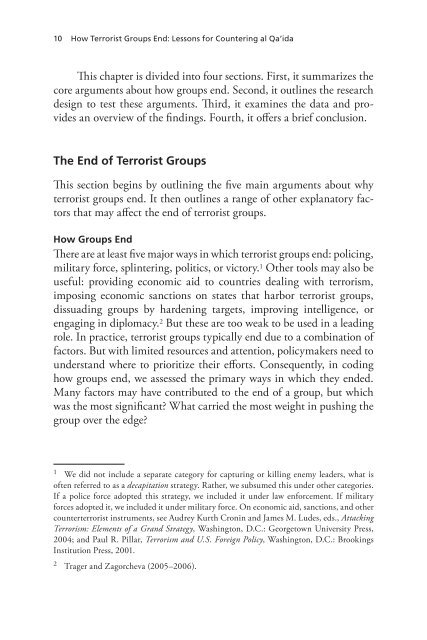How Terrorist Groups End - RAND Corporation
How Terrorist Groups End - RAND Corporation
How Terrorist Groups End - RAND Corporation
You also want an ePaper? Increase the reach of your titles
YUMPU automatically turns print PDFs into web optimized ePapers that Google loves.
10 <strong>How</strong> <strong>Terrorist</strong> <strong>Groups</strong> <strong>End</strong>: Lessons for Countering al Qa’ida<br />
This chapter is divided into four sections. First, it summarizes the<br />
core arguments about how groups end. Second, it outlines the research<br />
design to test these arguments. Third, it examines the data and provides<br />
an overview of the findings. Fourth, it offers a brief conclusion.<br />
The <strong>End</strong> of <strong>Terrorist</strong> <strong>Groups</strong><br />
This section begins by outlining the five main arguments about why<br />
terrorist groups end. It then outlines a range of other explanatory factors<br />
that may affect the end of terrorist groups.<br />
<strong>How</strong> <strong>Groups</strong> <strong>End</strong><br />
There are at least five major ways in which terrorist groups end: policing,<br />
military force, splintering, politics, or victory. 1 Other tools may also be<br />
useful: providing economic aid to countries dealing with terrorism,<br />
imposing economic sanctions on states that harbor terrorist groups,<br />
dissuading groups by hardening targets, improving intelligence, or<br />
engaging in diplomacy. 2 But these are too weak to be used in a leading<br />
role. In practice, terrorist groups typically end due to a combination of<br />
factors. But with limited resources and attention, policymakers need to<br />
understand where to prioritize their efforts. Consequently, in coding<br />
how groups end, we assessed the primary ways in which they ended.<br />
Many factors may have contributed to the end of a group, but which<br />
was the most significant? What carried the most weight in pushing the<br />
group over the edge?<br />
1 We did not include a separate category for capturing or killing enemy leaders, what is<br />
often referred to as a decapitation strategy. Rather, we subsumed this under other categories.<br />
If a police force adopted this strategy, we included it under law enforcement. If military<br />
forces adopted it, we included it under military force. On economic aid, sanctions, and other<br />
counterterrorist instruments, see Audrey Kurth Cronin and James M. Ludes, eds., Attacking<br />
Terrorism: Elements of a Grand Strategy, Washington, D.C.: Georgetown University Press,<br />
2004; and Paul R. Pillar, Terrorism and U.S. Foreign Policy, Washington, D.C.: Brookings<br />
Institution Press, 2001.<br />
2 Trager and Zagorcheva (2005–2006).

















